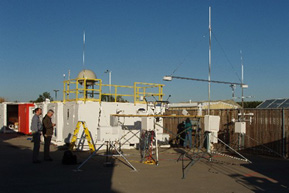Mobile Facility Beta Testing Complete; System Headed to California Seashore
Published: 31 January 2005
A key addition to the ARM Climate Research Facility scientific infrastructure is ready to roll…literally. In February, the ARM Mobile Facility (AMF) is being packed up and shipped from Richland, Washington, to the Point Reyes National Seashore north of San Francisco, California. There, it will be reassembled in preparation for its first deployment as part of a 6-month experiment to study the microphysical characteristics of marine stratus clouds, and in particular, marine stratus drizzle processes. Throughout the deployment, the AMF will accommodate aerosol observing equipment for National Oceanic and Atmospheric Administration (NOAA) researchers co-sponsored by ARM and the DOE Aerosol Science Program. Because similar equipment has been proposed as a future baseline AMF capability, this collaboration represents a prototype deployment with NOAA equipment.

After a year of engineering design, procurement, and construction, beta testing of the AMF began on January 3, 2004, at DOE’s Pacific Northwest National Laboratory. During the test period, the ARM Climate Research Facility operations staff monitored the station during normal work hours. They also launched one RS-92 radiosonde per day, requiring local notices to be in place with the Federal Aviation Administration one hour prior to each launch. The beta test allows the ARM Climate Research Facility operations and engineering staff to ensure proper operation of the full complement of instrumentation and to troubleshoot the data collection and transmission systems prior to the AMF’s first deployment.
Meanwhile, preparations continued for the Pt. Reyes deployment. As part of the permit review, the AMF Site Scientist gave a well-received presentation of the AMF to National Park Service (NPS) officials in November 2004. All permits were subsequently granted and the ARM Climate Research Facility infrastructure staff began coordinating their work with the NPS personnel. In December, they worked with NPS personnel to clean a vacant building, complete with an operational well and septic system, for the deployment team to use while on site. They also made plans to install a fence around the deployment site to keep nearby cattle away from the instruments. In January, the electrical infrastructure was installed, and a schedule for site operations and communications was established.
The ARM Climate Research Facility is a DOE Office of Science user facility. The ARM Facility is operated by nine DOE national laboratories, including .
Keep up with the Atmospheric Observer
Updates on ARM news, events, and opportunities delivered to your inbox
ARM User Profile
ARM welcomes users from all institutions and nations. A free ARM user account is needed to access ARM data.


















